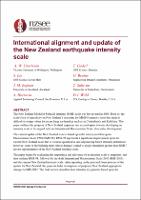| dc.contributor.author | Charleson, Andrew | |
| dc.contributor.author | Goded, Tatiana | |
| dc.contributor.author | Lin, Sheng-Lin | |
| dc.contributor.author | Beattie, Graeme | |
| dc.contributor.author | Ingham, Jason | |
| dc.contributor.author | Sullivan, Timothy | |
| dc.contributor.author | Hortacsu, Ayse | |
| dc.contributor.author | Wald, David | |
| dc.date.accessioned | 2023-08-28T04:23:23Z | |
| dc.date.available | 2023-08-28T04:23:23Z | |
| dc.date.issued | 2023-04-19 | |
| dc.identifier.uri | https://repo.nzsee.org.nz/xmlui/handle/nzsee/2566 | |
| dc.description.abstract | The New Zealand Modified Mercalli intensity (MMI) scale was last revised in 2008. Even so, the scale's lack of specificity on New Zealand's structures for MMI>8 intensity levels has made it difficult to assign values for recent large earthquakes such as Christchurch and Kaikōura. This paper outlines the progress of New Zealand engineers and seismologists towards developing an intensity scale that will be eventually be aligned with an International Macroseismic Scale, also under development.
The current update of the New Zealand scale is based upon the widely used and tested European Macroseismic Scale 1998 (EMS-98). EMS-98 represents a significant improvement upon the current New Zealand scale due to its more quantitative and engineering-based intensity definitions; however, some of the building types whose damage is used to assign intensities greater than MMI 7 are not representative of the New Zealand building stock.
This paper begins by explaining the importance of an intensity scale to engineers, and then outlines proposed EMS-98 modifications for its use domestically. First, European building types are reviewed, and then modified and extended, especially recognizing the dominance of light timber frame construction locally. Revised vulnerability classes and vulnerability modifiers are proposed. To further improve the consistency and accuracy of intensity values, detailed written and graphical descriptions of the damage grades that guide structural engineers’ field classifications are described. Finally, the paper concludes with a description of how intensity assignments based upon the proposed scale were calibrated using building damage datasets from several recent New Zealand earthquakes. | |
| dc.language.iso | en | |
| dc.publisher | New Zealand Society for Earthquake Engineering | |
| dc.relation.ispartofseries | 2023;63 | |
| dc.subject | Society, policy, and culture in understanding impacts and improving resilience | |
| dc.title | International alignment and update of the New Zealand earthquake intensity scale | |
| dc.type | Article | |

